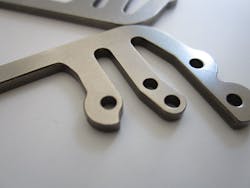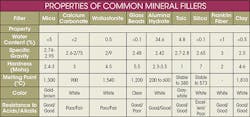Mineral Fillers Improve Plastics
Some plastic resins get blended with fillers to reduce costs. Properly used mineral fillers, however, can improve a plastic’s moldability and stability. They can also increase the plastic’s heat-deflection temperature, reduce thermal expansion, and change other performance characteristics as well. Some fillers also give plastics flame-retardant characteristics.
But there can be a penalty: the finished molded part might not be as strong. So engineers and designers should know the basics behind fillers and consult with resin suppliers to get the best version of a modified plastic for their application.
The Minerals
The minerals commonly used as fillers in plastic molding compounds include calcium carbonate, talc, silica, wollastonite, clay, calcium sulfate fibers (also known as Franklin fiber), mica, glass beads, and alumina trihydrate.
Alumina trihydrate gives plastic flame retardancy because it decomposed endothermically into alumina and water when heated above 220°C. However, its low decomposition temperature limits the use of alumina trihydrate to resins such as polyethylene and polypropylene which have relatively low processing temperatures.
Clay fillers improve electrical properties and processabilty of most resins. Mica, which boosts a resin’s mechanical properties, is used in the form of small brown flakes. Its characteristic hue limits the colorability or resins that contain it. Calcium sulfate fibers and wollastonite are bother fibrous or needle-like fillers and can either slightly improve or degrade mechanical properties. Glass beads, silica, calcium carbonate, and talc usually weaken plastics.
Hardness values of fillers range from 1.0 for talc to 7.0 for silica on the Mohs scale. Abrasiveness, a function of hardness, is particularly high in silica-filled composites. Tools used to work these composites can experience significant wear.
Form and Function
A filler’s size and shape largely determine the mechanical properties those fillers will impart. Fibers and prismatic particles, for example, usually increase both tensile and flex strength in all three orthogonal dimensions. Fillers shaped as spheres and cubes, however, raise neither property.
Flakes or plate-like fillers, which fall somewhere between spheres/cubes and fibers/prismatics, can reinforce strength in two directions because they usually become oriented in the direction of resin flow during molding. All filler shapes increase the resulting plastic’s modulus and contribute to the plastic’s dimensional and thermal stability
A filler material’s size also affects the plastic’s properties, most notably its tensile, flexural, and impact strengths. Particles range in average size from 1 to 10 microns for natural minerals and up to 30 microns for glass beads. Larger particles create greater stress concentrations in the plastic’s matrix. In general, small particles improve strength more than larger ones.
Variations in particle size for most filler materials range from about 20:1 to 40:1. Clay, however, can have size distributions that vary as much as 1,000:1. In general, the smaller and more uniform the particle size, the better the strength properties of the composite. It only takes a few large particles in an otherwise uniform distribution of small particles to significantly reduce the resulting strength.
The filler particles’ surface area also has an effect on the plastic’s properties, especially its processabilty. And surface area can vary from 20m2/g for clay to 1 m2/g for silica. A filler’s surface areas and the degree of wetting out that surface experiences helps determine the viscosity of the flowing resin during molding. Well-wetted mineral fillers flow more easily and lead to improved mechanical properties. But if the filler’s surface area is so large that there is too little resin available to wet the entire area, the resulting composite will have poorly dispersed filler and nonuniform properties.
Filler Effects
Mineral fillers with length-to-width ratios below 10:1 (low aspect ratios) contribute significantly to isotropic or uniform shrinkage and thus reduce warping in thermoplastic composites. However, limiting warping comes at the expense of tensile strength and other mechanical properties. Low-aspect ratio fillers such as talc also improve moldability and reducing molding cycle times.
High-aspect ratio fillers, those with fiber or plate-like shapes, help maintain or increase tensile strength compared to plastics without fillers. The downside is that these filler materials cost more than fillers (cues and spheres), and they tend to create non-uniform properties because of the orientation during mold filling.
To get more uniform properties, plastic suppliers have been relying on mica fillers. They provide a good balance of increased tensile strength, uniform properties, and much less mold shrinkage.
Fillers and Nylon 6/6
Nylon 6/6 and its variations are some of the more commonly used plastics, and fillers play a major role in how designers tailor the properties of nylon. For example, adding glass beads boosts nylon’s flexural modulus by 50%. Mica fillers increase it by 400%.
To reduce mold shrinkage of nylon, engineers can employ almost any mineral filler. Reductions in shrinkage then range from 30% with the addition of calcium carbonate to 85% by adding mica.
Nylon’s tensile strength can be adding silica, Franklin fiber, or mica, with mica increasing it the most (30%). All other mineral fillers lower the tensile strength of nylon.
For flame resistance, nylon and plastics should have talc or alumina hydrate fillers added. As these fillers are heated, they give off water, creating a quenching effect on flames. Adding other flame-retardant fillers can give plastics flame resistance ratings of UL 945Vo or V1.
Most fillers make plastics brittle, so they reduce impact strength. Silica, however, is an exception. Only silica-filled plastics and nylon have impact-strength values (unnotched) greater than 10 ft-lb, the lowest value at which plastics are considered to have practical toughness. The increase in toughness is likely due to the availability of coupling agents that are more effective at bonding silica and resins that for other fillers.
All fillers increase nylons’ thermal conductivity and reduce the coefficient of thermal expansion significantly. The effect of fillers on nylon’s heat-deflection temperatures, however, varies from a low of 390F for clay to 460°F for mica.
The wear factor, or relative wear rate, does not change much from nylon 6/6’s base value, 200 in3/ft-lb-hr by adding mica, silica, Franklin fiber, or calcium carbonate. The wear rates climb to under 500 with the addition of glass beads or hydrated alumina. Adding wollastonite, clay, or talc fillers vastly increases wear rates, making these fillers unsuitable for nylon composites that come in contact with rubber.
One way to increase nylon 6/6’s tensile strength, unnotched Izod impact strength, and heat-deflection temperature is to add mica and glass fiber fillers. However, this combination of these two fillers increases costs and makes molding non-uniform. It also increases the chances of parts warping due to fiber orientation during molding. A good compromise is a nylon 6/6 compound containing 15% glass fiber and 25% mica. This formula leads to a composite with a good price/performance profile that includes a 33% increase in tensile strength, nearly double the impact strength, and 30°F rise in heat-deflection temperature compared to a composite with 40% mica.

